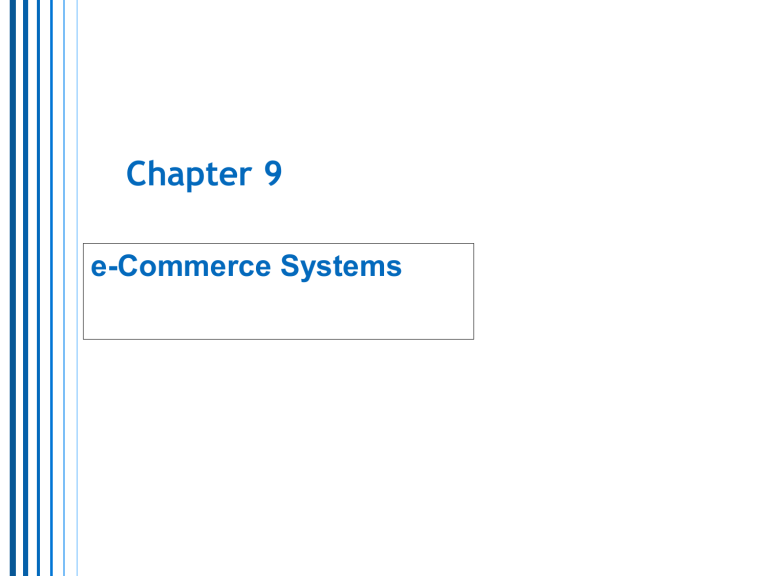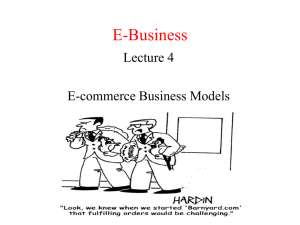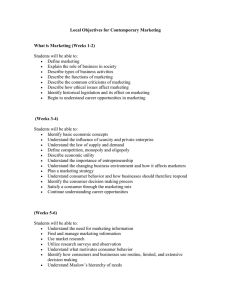Chapter 9 e-Commerce Systems

Chapter 9
e-Commerce Systems
Section 1
E-Commerce Fundamentals
2
I. Introduction to e-Commerce
Electronic Commerce – the entire online process of developing, marketing, selling, delivering, servicing, and paying for products and services transacted on networked global marketplaces; more than just buying and selling online
e-Commerce Technologies – involves most information and Internet technologies
3
II. The Scope of e-Commerce
4
II. The Scope of e-Commerce
Categories of e-Commerce
Business-To-Consumer (B2C) e-Commerce – still small when compared with all online commerce
Consumer-To-Consumer (C2C) e-Commerce – online auctions, online advertising of personal products and services
Business-To-Business e-Commerce – most of e-
Commerce is here
Business-To-Government (B2G) e-Commerce
5
III. Essential e-Commerce Processes
6
III. Essential e-Commerce Processes
Access Control and Security – secure access between parties to assure trust
Profiling and Personalizing – processes that gather data on you and your behavior to provide personalized service; this may raise ethical issues
Search Management – effective and efficient search processes are required for a good Web site; there are more than 30 different search engines on the Internet
7
III. Essential e-Commerce Processes
Content and Catalog Management
helps e-commerce firms develop, generate, deliver, and archive text and multimedia data
works with profiling tools
may include product configuration to support customer self-service and mass customization
Workflow Management – ensure proper transactions, decisions, and work activities are performed, and documents distributed correctly
8
III. Essential e-Commerce Processes
Event Notification – monitor all e-commerce processes and record all relevant events; most e-commerce applications are event-driven and respond to things that happen (events)
Collaboration and Trading – a major category of e-commerce; processes consist of collaboration and trading services needed by various stakeholders
9
IV. Electronic Payment Processes
Very complex due to the anonymous nature of electronic transactions
Web Payment Processes – most rely on credit card payment processes
Electronic Funds Transfer (EFT) – a variety of information technologies to capture and process money/credit transfers between banks, businesses, and customers
10
IV. Electronic Payment Processes
Secure Electronic Payments – measures taken to ensure security of information in electronic payments
Encrypt data between customer and merchant
Encrypt data between customer and firm authorizing credit cards
Take sensitive information offline
11
IV. Electronic Payment Processes
A Secure Electronic Payment System
12
Section 2 e-Commerce Applications and Issues
13
I. Introduction
e-commerce has changed how firms do business and is now defining how firms do business
e-Commerce Trends
14
II. Business-To-Consumer (B2C) e-Commerce
Attract potential customers, transact goods and services, build customer loyalty
e-Commerce Success Factors
Selection and Value – attractive products, competitive prices
Performance and Service – easy navigation and purchasing, prompt shipping and delivery
Look and Feel – attractive Website, multimedia catalog
Advertising and Incentives – targeted Webpage advertising, email promotions, discounts, special offers
15
II. Business-To-Consumer (B2C) e-Commerce
Personal Attention – personalized Web pages and product recommendations, email notices, interactive support
Community Relationships – virtual communities and links to related Web sites
Security and Reliability – security of customer information and transactions, trustworthy product information, reliable order fulfillment
Great Customer Communications – easy-to-find contact information, online order status, product support
16
II. Business-To-Consumer (B2C) e-Commerce
Traditional Vs. Web Market
Communications
17
III. Web Store Requirements
Getting Customers to Find You – customers must find you on the Web -
Search Engine Optimization (SEO) – focus on improving the number/quality of visitors to a Web site
Web Cookie File – a file stored on the customer’s computer with details about their visit to your Web site
18
V. e-Commerce Marketplaces
A Sample B2B e-Commerce Web Portal
19
VI. Clicks and Bricks in e-Commerce
Should virtual electronic business be combined with physical operations or kept separate?
e-Commerce Integration – the Internet is just another channel that gets plugged onto the business architecture
Other Clicks and Bricks Strategies – partial integration of e-commerce into the physical business operations, or complete separation of the two
e-Commerce Channel Choices – a marketing/sales channel created to conduct/manage e-commerce activities
20
VI. Clicks and Bricks in e-Commerce
An Integrated Vs. Separate e-Commerce
Business
21




